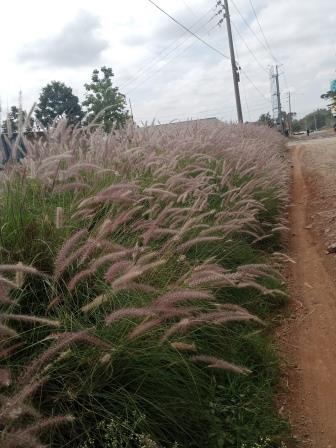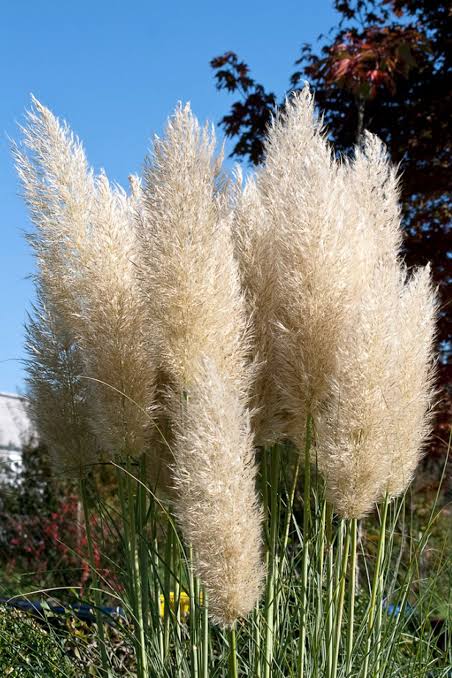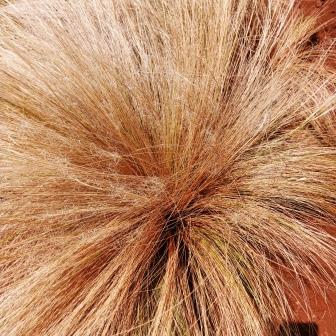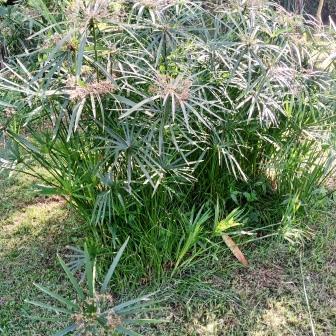Did you know that as tall and bushy as bamboo get, they are actually grasses?
Well bamboo is a member of vast family of plants that grow wild thorough out the world that is known as true grasses. A few of these grasses are grown as lawns in gardens but many grasses are valued for their slender, sometimes coloured leaves and feathery inflorescence. Other grasses have architectural forms prized in landscaping
Some like pennisetum bear a decorative seed heads, others are more suitable for indoor displays.


Description : What are grasses?
Grasses are evergreen or deciduous, annual or perennials that belong to the graminae family. They have erect or arching stems that are usually round and hollow with regular spaced nodes. The leaves are borne in two ranks from the sheath, which may be split or peeled back.
Grass colours can vary from silver blue, red yellow, as well as shades of green. Grasses will grow either as clumping or spreading grasses.
Some ornamental grasses have attractive variegated leaves with longitudinal stripes or cross bands.
Flowers: They are usually light and feathery. Ornamental grasses have showy flower heads that grow in form of spikes, panicles or racemes of tiny spikelets .Many flower heads are suitable for cutting and display indoors either as fresh or dried flowers
How To Use Grasses in Landscaping
Imposing grasses like pampas (cortaderia selloana) are excellent as specimen or focal points.
Grasses are also ideal for mixed borders where their vertical heights and soft curves contrast beautifully with more rounded broader leafed plants.
Grasses add interest and create movement in the garden as they sway in the wind. Their fast growth and ever changing appearance throughout the seasons add much interest to the garden.


(a) Grasses are ideal as container plants.
Pennisetum, pampas, phomiums, mondo grass, bamboo, liriope and fescue make for remarkable container growers. Every pot size has suitable grass than will garland it.
(b) Use grass in landscaping to control soil erosion
When massed grasses can help control soil erosion by stabilizing soil on steep slopes. This is due to their deep root systems. Virtually all grasses can be used for erosion control. You can pick from any of these;
- Penisetums,
- mondo grass(Kyoto dwarf)
- kikuyu grass.
- Paspalum
- Bamboo
- Fescue
- Bermuda
- Buffalo
- Zoysia
- Blue grass
Grasses as groundcovers
The most popular use of grass is as a ground cover within the gardens. Lawns are the primary use of grasses in landscaping and applied appropriately provides an arresting backdrop against which other garden elements are viewed.
Grasses as aquatic plants
Grasses for aquatic environments Grasses like sedges, rushes and cyperus are good or water logged areas or swamps. They can be used to rehabilitate marshes and swamps as well as for water features in the gardens

How grasses grow
Though grasses are a large group, they almost share the same growing needs; well-drained soil and full sun. Once established grasses require little or no maintenance depending on the type used. Ideally grow grasses that require damp soil near a water feature.
A few grasses like mondo grass will grow in partial or full shade. Space your grasses well as they grow and spread out. Most ornamental grasses are available in containers. Potted grasses are planted by loosening the roots and spreading out in the planting hole. Firm the soil to remove air pockets. The crown (root ball and plant joint should either be even with the soil surface or slightly below it). Water thoroughly. If your grass develops a well-established root system, they will survive drought without fanfare.
How to propagate grasses
Propagation is by seeds.
Sow seeds directly onto prepared ground. The ground must be done to fine tilth. Ideally thoroughly wet the ground a day before sowing as splashes of water can scatter the tiny seeds.
Division
Divide mature grass by splitting up at the root ball.
Cutting
This is where grass is grown by springs or cutting. Spring are inserted into the ground and watered till they shoot again.
Sods
Pre-panted grass is laid out in form of carpets
Common grass problems
Most grasses are often trouble-free provided they are planted in the right environment.
Improper planting conditions like poor light, air circulation, or excessive fertilization will negatively affect your grass.


Leave a Reply